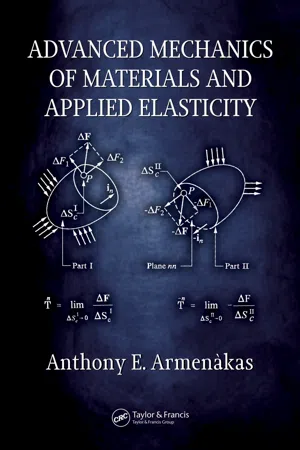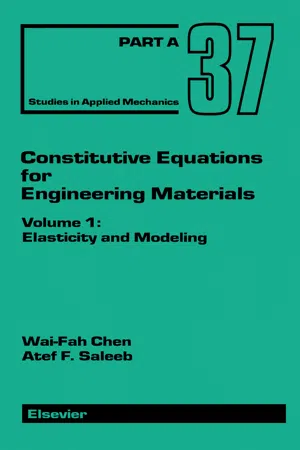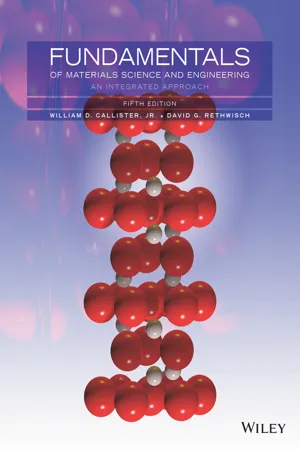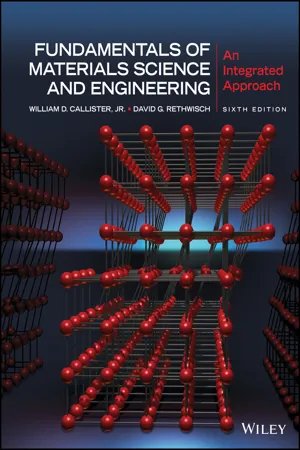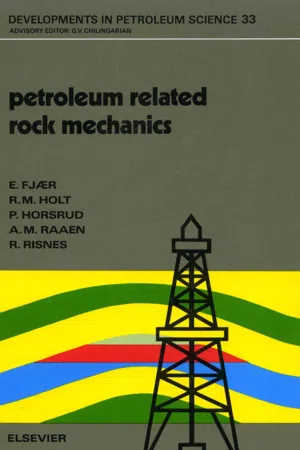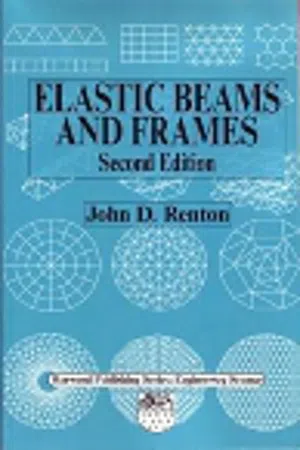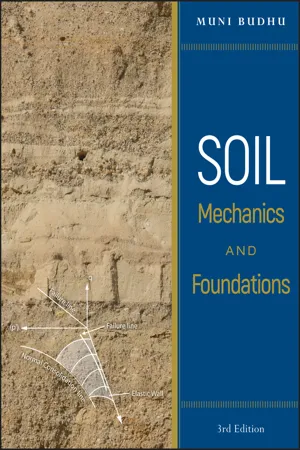Physics
Elastic Strain
Elastic strain refers to the temporary deformation of a material in response to an applied force, which is reversible when the force is removed. This type of strain occurs within the elastic limit of a material, meaning it can return to its original shape and size once the force is released. It is characterized by the material's ability to store and release energy without permanent damage.
Written by Perlego with AI-assistance
Related key terms
1 of 5
11 Key excerpts on "Elastic Strain"
- eBook - PDF
Physics of Continuous Matter
Exotic and Everyday Phenomena in the Macroscopic World
- B. Lautrup(Author)
- 2011(Publication Date)
- CRC Press(Publisher)
7 Strain All materials deform when subjected to external forces but different materials react in different ways. Elastic materials bounce back again to the original configuration when the forces cease to act. Others are plastic and retain their shape after deformation. Viscoelastic materials behave like elastic solids under rapid deformation, but creep like viscous liquid over longer periods of time. Elasticity is itself an idealization limited to a certain range of forces. If the external forces become excessive, all materials become plastic and undergo permanent deformation or may even fracture. When a body is deformed, its material is displaced away from its original position. Small deformations are mathematically much easier to handle than large deformations where parts of a body become greatly and non-uniformly displaced relative to other parts, as for example when you crumple a piece of paper. A rectilinear coordinate system embedded in the original body and deformed along with the material of the body becomes a curvilinear coordinate system after the deformation. It can therefore come as no surprise that the general theory of finite deformation is mathematically at the same level of difficulty as general curvilinear coordinate systems. Luckily our buildings and machines are rarely subjected to such violent treatment, and in most cases the deformation may be assumed to be tiny. Although displacement is naturally described by a vector field, the description of defor-mation inevitably leads to the introduction of a new tensor quantity, the strain tensor , which characterizes the state of local deformation or strain in a material. It can come as no surprise that material strain causes tension or stress—as do strained relations among people. In this chapter we shall focus exclusively on the description of strain, and postpone the discussion of the stress-strain relationship for elastic materials to Chapter 8. - Anthony E. Armenakas(Author)
- 2016(Publication Date)
- CRC Press(Publisher)
Moreover, these sets of components of stress and strain satisfy the following relation: ij ij ij The left side of relation (3.38a) is equal to zero only if = and, consequently, e (2) (1) (2) ij = e . Inasmuch as relation (3.38a) is valid for any two sets of values of the components (1) of stress, it will also hold when the differences of the components of stress and strain are infinitesimal. Thus, Elastic materials possessing the property (3.38) are called stable . An elastic material is an idealization approached by some materials. In reality, even when a body is subjected to very small forces, some permanent distortion of its microscopic structure occurs. Consequently, for any load, no matter how small, there is some permanent deformation and some energy is lost during the process of loading and unloading. When the applied forces are not very large, the permanent deformation of bodies made from certain materials within a certain range of temperature is of a smaller magnitude than we are able to observe. Moreover, the energy lost per cycle of loading and unloading is small and can be disregarded except in cases involving many cycles. For instance, in the case of a vibrating metal part, the energy lost results in the damping of the vibrations. The response of these materials is considered as elastic . As the applied forces increase, the permanent deformation reaches detectable magnitudes. It becomes evident that the body does not recover its original volume and shape upon unloading. The process of deformation has obviously become irreversible . However, the relations among the components of stress and strain do not depend upon time but upon the direction and path of loading. That is, while elastic deformation depends only upon the initial and final states of stress, the total irreversible time-independent deformation depends upon both the final state of stress and the path of loading.- eBook - PDF
Ultrasonic Spectroscopy
Applications in Condensed Matter Physics and Materials Science
- Robert G. Leisure(Author)
- 2017(Publication Date)
- Cambridge University Press(Publisher)
2 Elasticity Chapter 2 deals with the elastic response of materials, where elastic has the usual meaning that a material returns to its original configuration after the removal of a deformation-causing force. In fact, linear elasticity will be assumed, for which the distortion from the equilibrium configuration is directly proportional to the applied force. In the present chapter, classical elasticity will be discussed, in which case the solid is treated as a continuum, and the discreteness of the underlying lattice is ignored [4]. This approach is only valid when the length scale of the spatial variations is much greater than the lattice constant, the usual situation for ultrasonic vibrations in solids. Knowledge of classical elasticity is essential for an understanding of ultrasonic vibrations and the propagation of ultrasonic waves in materials. 2.1 Strain 2.1.1 The Strain Tensor The problem at hand is to describe the distortions of a material from the equilibrium configuration. Consider a point in a solid relative to an origin fixed in space. Before deformation, the position of the point is given by r. After deformation, the position is given by r = r + u. Thus, the displacement of a point from its equilibrium position is u = r − r. (2.1) In the case of interest, u is a function of r, i.e u(r), otherwise the displacement just corresponds to a uniform displacement of the material, and is not relevant to the present discussion. A brief discussion of u(r) follows, leading to an expression for the strain tensor. 4 2.1 Strain 5 A B dr u A u B u B u A du (a) (b) A dr B Figure 2.1 (a) The two points A and B are initially separated by the vector dr. After a distortion the points are separated by the vector dr . (b) The vector du is shown. Figure 2.1 shows two points in the material, A and B, which are originally separated by dr. After a distortion the points move to A and B respectively and are separated by dr . - eBook - PDF
Constitutive Equations for Engineering Materials
Elasticity and Modeling
- Wai-Fah Chen, Atef F. Saleeb(Authors)
- 2013(Publication Date)
- Elsevier(Publisher)
4.4 DEFINITIONS Elastic Material A material body is deformed when subjected to applied forces. If upon the release of the applied forces the body recovers its original shape and size, then the material body is called elastic. For such a material, the current state of stress depends only on the current state of deformation; that is, the stress is a function of strain. Mathematically, the constitutive equations for this material are given by fy = ^(e w ) (4-3) where the function F tJ is the elastic response function. Thus the elastic behavior described by Eq. (4.3) is both reversible and path independent in the sense that strains are uniquely determined from the current state of stress or vice versa. There is no dependence of the behavior on the stress or strain histories followed to reach the current state of stress or strain. The elastic material defined above is usually termed Cauchy elastic material (e.g., Eringen, 1962; 148 ELASTIC STRESS-STRAIN RELATIONS and Malvern, 1969). It can be shown that Cauchy elastic material may generate energy under certain loading-unloading cycles. Clearly, in such cases it violates the laws of thermodynamics. Therefore, the term hyperelastic or Green elastic material is used (e.g., Fung, 1965; Eringen, 1962; Green and Zerna, 1954; and Malvern, 1969) to indicate that the elastic response function in Eq. (4.3) is further restricted by the existence of an Elastic Strain energy function W, which is in general a function of strain components e iJ9 such that m (A A This ensures that no energy can be generated through load cycles and thermo-dynamic laws are always satisfied. Sometimes the term hypoelastic model is used to describe the incremental elastic constitutive relations (e.g., Malvern, 1969; and Truesdell, 1955). These models are often used to describe the behavior of a class of materials in which the state of stress is generally a function of the current state of strain as well as of the stress path followed to reach that state. - eBook - PDF
- George C. King(Author)
- 2023(Publication Date)
- Wiley(Publisher)
In Figure 9.1a, a bar is stretched; in Figure 9.1b, a rectangular block is sheared, i.e. twisted; and in Figure 9.1c, a spherical object is compressed uniformly on all sides. What the three forms of deformation have in common is that a deforming force called stress produces a deformation called strain. For stretching in just one direction, the stress is called tensile stress; for twisting, it is called shear stress; and for volume compression, it is called bulk stress. So long as the deformation is relatively Physics of Matter, First Edition. George C. King. © 2023 John Wiley & Sons Ltd. Published 2023 by John Wiley & Sons Ltd. small, it is found empirically that stress and strain are linearly proportional to each other. The constant of proportionality is called the modulus of elasticity, so that Stress Elastic modulus Strain (9.2) We make a distinction here between a modulus of elasticity and the spring constant of Hooke’s law. Hooke’s law when applied to a particular object such as a spring deals with the details of the object in its entirety; its shape, size, the material it is made from and how that material was prepared. By contrast, an elastic mod- ulus depends only on the material of which the object is made. 9.1.1 Tensile and compressional stress and strain Figure 9.2 shows a bar of material that initially has length l and cross-sectional area A. It is secured to a rigid wall at one end and a longitudinal force F is applied to the other end. There is a reactive force at the wall that has the same magnitude as the applied force but acts in the opposite direction. This ensures that the bar has no tendency to move left or right, although it is in tension. When an object is stretched in only one direction, the tensile stress is defined as the ratio of the applied force F to the cross-sectional area A: Tensile stress F A (9.3) This is a scalar quantity because F is the magnitude of the force. - eBook - PDF
Fundamentals of Materials Science and Engineering
An Integrated Approach
- William D. Callister, Jr., David G. Rethwisch(Authors)
- 2016(Publication Date)
- Wiley(Publisher)
The slope of this linear segment corresponds to the modulus of elasticity E. This modulus may be thought of as stiffness, or a material’s resistance to elastic deformation. The greater the modulus, the stiffer is the material, or the smaller is the Elastic Strain that results from the application of a given stress. The modulus is an important design parameter for computing elastic deflections. Elastic deformation is nonpermanent, which means that when the applied load is released, the piece returns to its original shape. As shown in the stress–strain plot (Figure 7.5), application of the load corresponds to moving from the origin up and along the straight line. Upon release of the load, the line is traversed in the opposite direction, back to the origin. modulus of elasticity elastic deformation 7.3 STRESS–STRAIN BEHAVIOR : VMSE Metal Alloys Hooke’s law— relationship between engineering stress and engineering strain for elastic deformation (tension and compression) Tutorial Video: Calculating Elastic Modulus Using a Stress vs. Strain Curve - eBook - PDF
Fundamentals of Materials Science and Engineering
An Integrated Approach
- William D. Callister, Jr., David G. Rethwisch(Authors)
- 2021(Publication Date)
- Wiley(Publisher)
The slope of this linear segment corresponds to the modulus of elasticity E. This modulus may be thought of as stiffness, or a material’s resistance to elastic deformation. The greater the modulus, the stiffer is the material, or the smaller is the Elastic Strain that results from the application of a given stress. The modulus is an important design parameter for computing elastic deflections. Elastic deformation is nonpermanent, which means that when the applied load is released, the piece returns to its original shape. As shown in the stress–strain plot (Figure 7.5), application of the load corresponds to moving from the origin up and along the straight line. Upon release of the load, the line is traversed in the opposite direction, back to the origin. σ = E ε modulus of elasticity elastic deformation 7.3 STRESS–STRAIN BEHAVIOR VMSE Metal Alloys Hooke’s law— relationship between engineering stress and engineering strain for elastic deformation (tension and compression) Tutorial Video: Calculating Elastic Modulus Using a Stress vs. Strain Curve 7.3 Stress–Strain Behavior • 199 - eBook - PDF
Introduction to Physics
Mechanics, Hydrodynamics Thermodynamics
- P. Frauenfelder, P. Huber(Authors)
- 2013(Publication Date)
- Pergamon(Publisher)
If we distort an initially unstressed, isotropic material (such as a steel rod) by a tension or a compression, the principal axes of deformation coincide with the principal axes of stress. For stresses which are not too great, the defor-mation is directly proportional to the stress. This is a general statement of Hooke's law. For its precise formulation, we introduce the concept of strain. The longitudinal strain e of a rod is defined as the ratio of its deformation or change of length AI to its original length /: It follows from this definition that ε is a pure number. Hooke's law now states that the strain is directly proportional to the stress producing it (see Fig. 5-10). If the normal stress in the rod is σ ΧΧ9 then where Γ is a constant, characteristic of a material, and is known as Young's modulus. (In some books, Young's modulus is denoted by the symbol E.) If / = 1 unit of length and a xx = 1 unit of stress, then 52-i Hooke's Law ~ Y ' (52-1) or 0 6 FIG. 5-10. Hooke's Law relationship. 220 INTRODUCTION TO PHYSICS That is, the reciprocal of Y is equal numerically to the increase in length of a rod of unit length, acted on by unit stress. Dimensions: [Y] = [ML-1 !-2 ] Units: cgs system: 1 dyne/cm 2 , mks system: 1 newton/m 2 , fps system: 1 lbf/'ft 2 . In engineering practice, Yis often expressed in lbf/in 2 . The significance of Young's modulus Y is not self-evident. For example, Young 's modulus for steel is about 3 χ 10 7 lbf/in 2 . This means that a rod 1 ft long, subjected to a tensile stress of 1 lbf/in 2 , increases in length by 1/3 χ 10 7 ft. When a rod is stretched by a tensile stress, the transverse dimensions decrease and hence its cross-sectional area decreases. The transverse strain δ is defined as the ratio of the deformation Ab in a transverse dimension to the original value b of this dimension: Like ε, Ó is a pure number. - eBook - PDF
- E. Fjær, Per Horsrud, Arne Marius Raaen, R. Risnes, Rune Martin Holt, P. Horsrud, A.M. Raaen, R.M. Holt(Authors)
- 1992(Publication Date)
- Elsevier Science(Publisher)
Chapter 1 Elasticity Most materials have an ability to resist and recover from deformations produced by forces. This ability is called elasticity. It is the foundation for all aspects of rock me- chanics. The simplest type of response is one where there is a linear relation between the external forces and the corresponding deformations. When changes in the forces are sufficiently small, the response is (nearly) always linear. Thus the theory of linear elasticity is fundamental for all discussions on elasticity. Linear elasticity of solid ma- terials is described in Section 1 .l. The region of validity for linear elasticity is often exceeded in practical situations. Some general features of non-linear behaviour of rocks are described in Section 1.2. In petroleum related rock mechanics, much of the interest is furthermore focused on rocks with a significant porosity as well as permeability. The elastic theory for solid materials is not able to fully describe the behaviour of such materials, and the concept of poroelasticity has therefore to be taken into account. The elastic response of a rock material may also be time dependent, so that the deformation of the material changes with time, even when the external conditions are constant. The elastic properties of po- rous materials and time-dependent effects are described in Sections 1.3 and 1.4, re- spectively. 1.1 Linear elasticity The theory of elasticity rests on the two concepts stress and strain. These are de- fined in 8 1.1.1 and 8 1.1.2. The linear equations relating stresses and strains are dis- cussed in 8 1.1.3 for isotropic materials, and in Q 1.1.4 for anisotropic materials. 1.1.1 Stress Consider the situation shown in Fig. 1.1. A weight is resting on the top of a pillar. Due to the weight, a force is acting on the pillar, while the pillar reacts with an equal, but reversely directed force. - eBook - PDF
- J D Renton(Author)
- 2002(Publication Date)
- Woodhead Publishing(Publisher)
3.4 Elasticity [Ch. 3 are not completely independent of one another. For example, from (3.9), (3.10) and (3.1 l), {Likewise, from (3.9) to (3.13), a*y, = azcw a*en ayaz azZ ayz - -+ -and (3.14) (3.15) (3.16) (3. t 7) (3.18) (3.19) These equations are not entirely independent of one another. They are related by Bianchi‘s identities, see Renton (1987) $1.5.5.) 3.3 Linear Elastic Behaviour of Isotropic Materials A material is said to be isotropic if it exhibits the same properties in any direction within it. Most engineering materials are taken to be isotropic, although the overall properties of fibre- reinforced materials must be related to the direction of the fibres. The consideration of such miso/ropic materials will be left until later. A material is elasfic if the strain response to loading is exactly reversed on unloading. If this response is such that the strains induced are exactly in proportion to the stresses applied, then the material is said to be linearly elastic. Usually, engineering materials are treated as linearly elastic in the working range of their loading. In an elastic design analysis, the maximum stresses are restricted to some fraction of the yield stress, and typically this corresponds to a normal strain of the order of 0.001’. At such small deformations, small deflexion theory is usually applicable (see $1.2) and for linear elastic behaviour, the properties of a linear response also normally apply (see $ I .4). Hooke’s law merely stated that there was a linear relationship between load and deflexion, and marked the beginning of the theory of elasticity (see the Preface). Young’s modulus, E, in the generally accepted form defined by Navier, relates a normal stress, u, to the normal strain which it induces in the same direction, E, in the equation o = Ee (3.20) ’ Note that strains are dimensionless. This same strain could have been written as a percentage (0.1%) or as 1000 microstrains (a microstrain being 10-9. - eBook - PDF
- Muniram Budhu(Author)
- 2011(Publication Date)
- Wiley(Publisher)
Then a plot of the stress–strain relationship will be a curve, as illustrated by OB in Figure 7. 5. In this case, the material comprising the cylinder is called a nonlinearly elastic material. If we apply a load P 1 that causes a displacement Dz 1 on an elastic material and a second load P 2 that causes a displacement Dz 2 , TABLE 7. 1 Typical Values of Poisson’s Ratio Soil type Description n a Clay Soft 0.35–0.40 Medium 0.30–0.35 Stiff 0.20–0.30 Sand Loose 0.15–0.25 Medium 0.25–0.30 Dense 0.25–0.35 a These values are effective values, n9. Stress ( z ) Strain ( z ) O Linearly elastic A B Slope is E, the initial tangent elastic modulus Slope is E s , the secant elastic modulus Nonlinearly elastic Slope is E t , the tangent elastic modulus σ ε FIGURE 7. 5 Linear and nonlinear stress–strain curves of an elastic material. then the total displacement is Dz 5 Dz 1 1 Dz 2 . Elastic materials obey the principle of superposition. The order in which the load is applied is not important; we could apply P 2 first and then P 1 , but the final displacement would be the same. Some materials—soil is one of them—do not return to their original configurations after unloading. They exhibit a stress–strain relationship similar to that depicted in Figure 7. 6, where OA is the loading response, AB the unloading response, and BC the reloading response. The strains that occur during loading, OA, consist of two parts—an elastic or recoverable part, BD, and a plastic or unrecoverable part, OB. Such material behavior is called elastoplastic. Part of the loading response is elastic, the other plastic. As engineers, we are particularly interested in the plastic strains since these are the result of permanent deformations of the material. But to calculate the permanent deformation, we must know the elastic deformation. Here, elastic analyses become useful. The stress at which permanent deformation initiates is called the yield stress.
Index pages curate the most relevant extracts from our library of academic textbooks. They’ve been created using an in-house natural language model (NLM), each adding context and meaning to key research topics.

